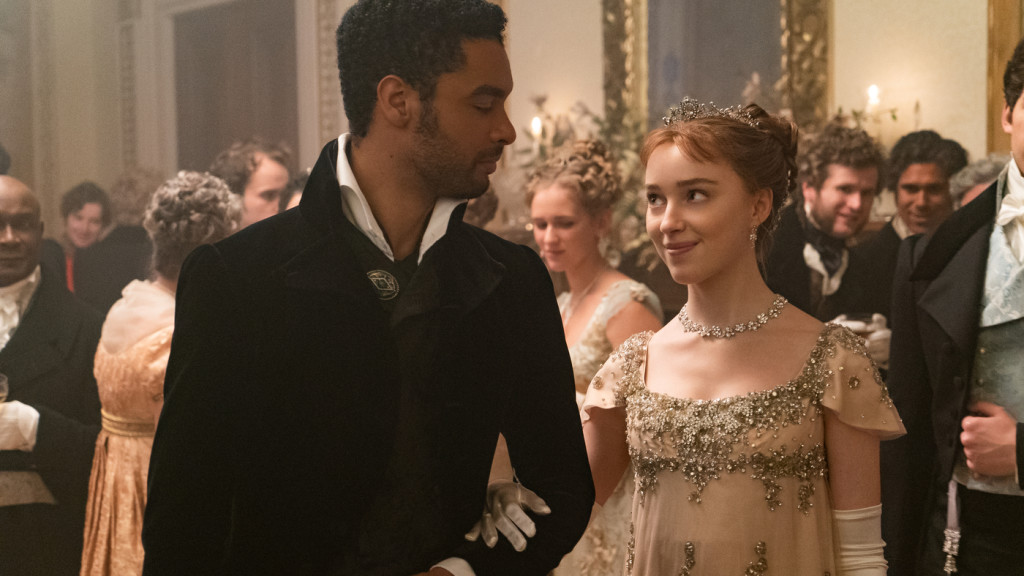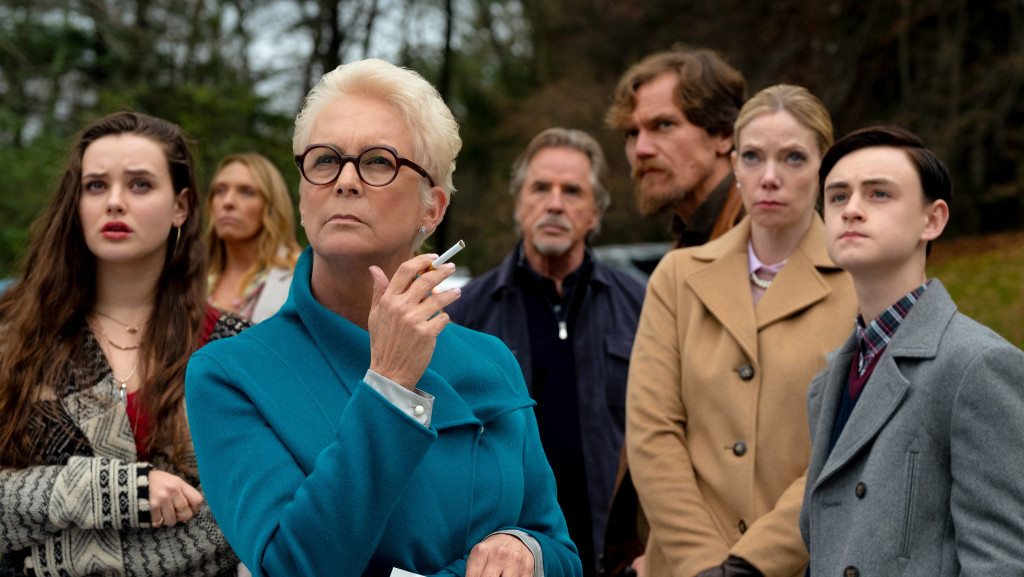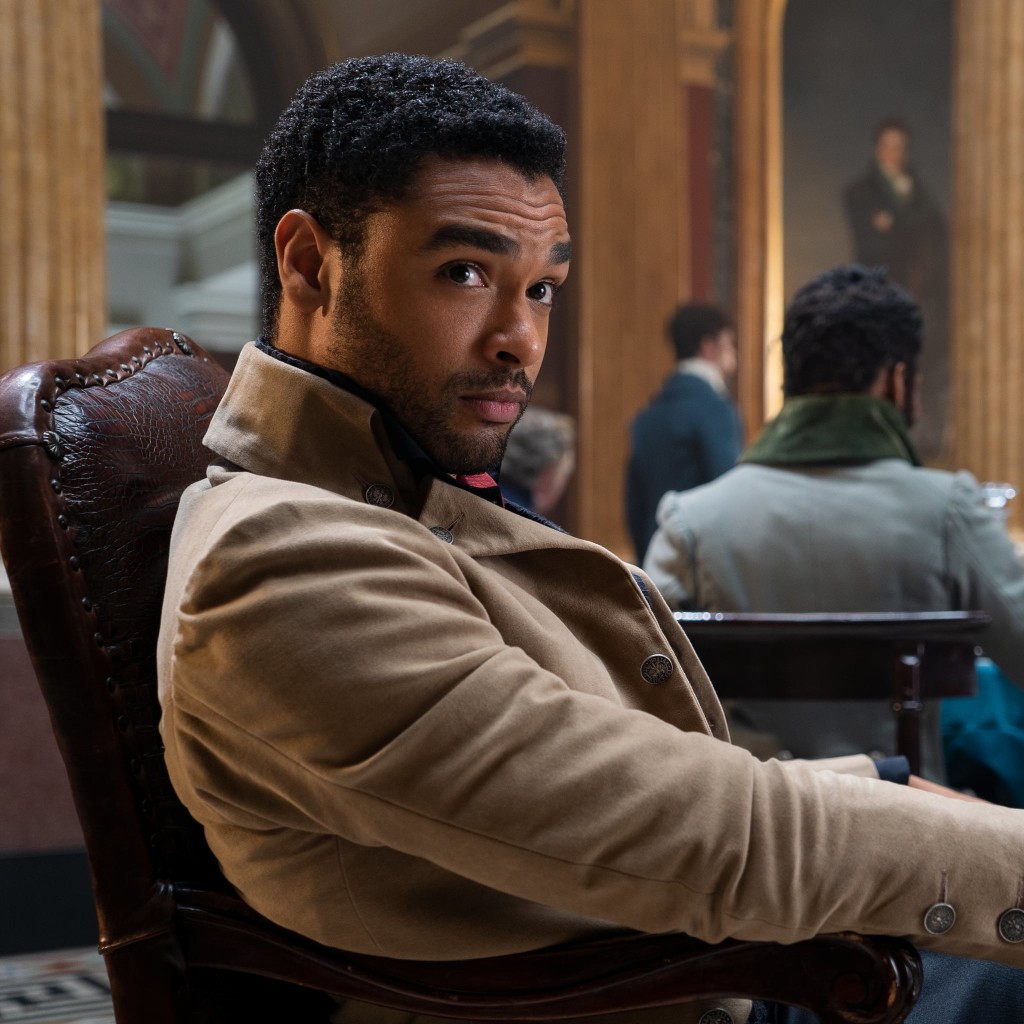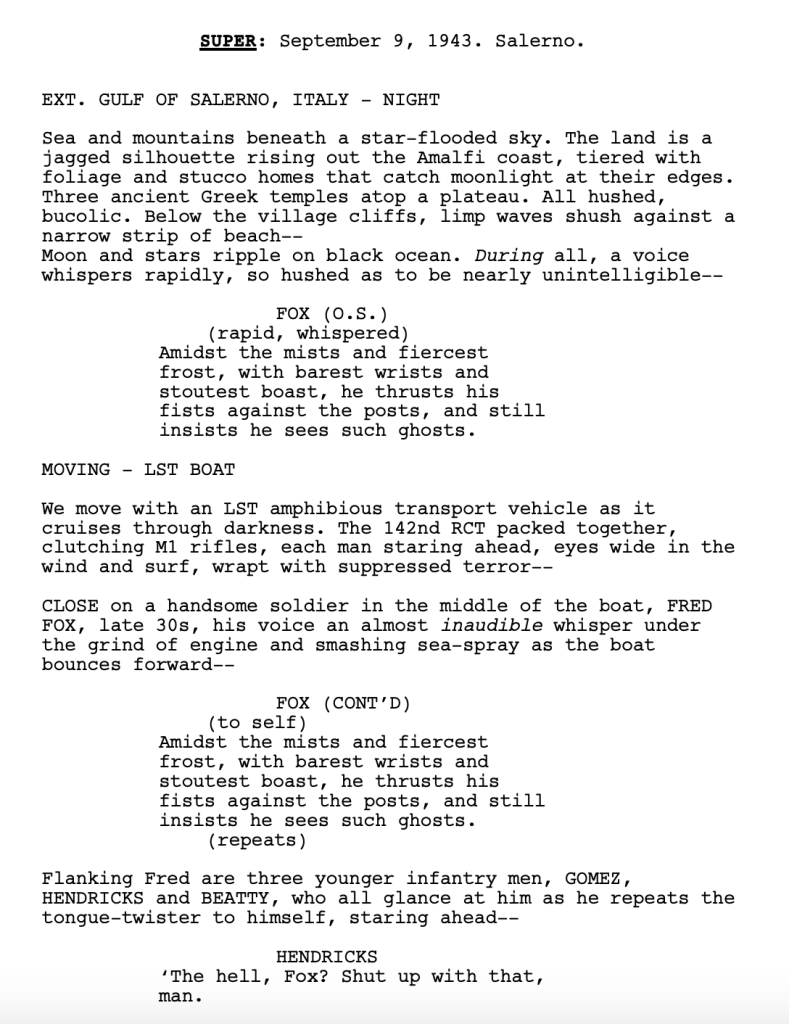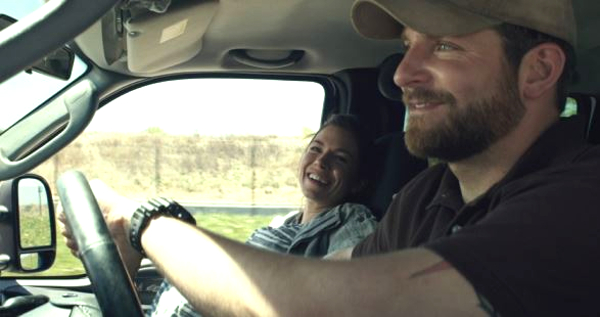Genre: TV – Period Drama (Pilot Episode)
Premise: Set in the competitive world of London’s mating season, when debutantes are presented at court.
About: This is Shonda Rhimes’s first big play on Netflix, and she didn’t come lightly. This looks like it cost a billion dollars to produce. Netflix opened up that pocketbook and didn’t close it. That approach seems to have paid off because, according to Netflix, Bridgerton is the most watched program on the streamer ever over its first month, tallying up 82 million household watches.
Writer: Chris Van Dusen (produced by Shonda Rhimes) (based on the novels by Julia Quinn)
Details: 60 minutes
The time has come.
I’ve received over 650 e-mails about it. Asking me when am I going to do a stinking review for the sumptuous Bridgerton? And by 650 e-mails I mean two e-mails. It’s taken Netflix by storm. It’s taken you all by storm. And pray-tell it has taken me by storm. Not a day has gone by that I haven’t thought about Bridgerton. Although that’s mainly because it’s the first show pictured whenever I open up Netflix but that’s neither here nor there.
Now while the manner in which the following review is written would seem to indicate I didn’t give this show a chance, I promise you that is not true. I’m not going to swear on my life or anything to promise you that. And, truth be told, I’m probably lying. But, hey, I’m the first to admit that “Cinderella with sex” isn’t the worst pitch.
Join me now, as I attempt to make sense of… Bridgerton.
So there’s this woman. Her name is “Lady Whistledown.” She runs a gossip blog but it’s the olden times version of a gossip blog so it’s printed on a pamphlet. Nobody knows who Lady Whistledown is, which confuses me since there are probably 3 printing presses in the entire world at this point and since very few people would have access to such a device, you could figure out who Lady Whistledown was through process of elimination. Assuming there are 10 buildings total in each town, just hang outside the printing press building until you find a suspicious-looking 50-something lady with 500 blank pamphlets walk inside.
Anyway, Lady Whistledown is obsessed with our heroine, the porcelain-skinned doe-eyed Daphne Bridgerton. Daphne hops on Whistledown’s radar when she gets the attention of the Queen! You see, back then, the Queen would spend entire days having women march into her throne room so she could either give them a ‘nay’ or a ‘yay.’ Sort of like their version of America’s Got Talent. But there’s only one Simon Cowell. And it’s a woman. And this Simon Cowell woman gets creepy ecstatic when she sees Daphne, bestowing upon her a forehead kiss, which makes everyone else in the room whisper to each other loudly. Meaning ‘This is a big deal!’ I’m glad they showed that loud whispering because otherwise I would’ve had no idea that it was a big deal.
ALLLLLL the men are now obsessed with Daphne and want her to husband them. It’s a little confusing, though, because Daphne is beautiful and the Bridgerton family already had a good name before this so it seems like she would’ve done well in the husband market anyway. But I guess this is like the difference between having access to regular dudes and celebrity dudes. Zak the scruffy-suited school teacher versus Zak Efron.
Either way, it seems like Daphne’s got it made. But there’s a big bad obstacle standing in her way. Her impossible brother, the Duke of Ellington! Actually, he’s not the Duke of Ellington but every guy in this show looks like a Duke of Ellington. So whenever I didn’t know someone’s name I mentally named them the Duke of Ellington. Point being, no husband is good enough for her brother. Which is cramping Daphne’s wedding plans.
Oh! I almost forgot to tell you. There’s this really studly guy that Daphne is attracted to named Simon Basset. But guess what? SIMON DOESN’T WANT TO GET MARRIED! Yikes, what?? Yeah. And he’s the only guy Daphne’s truly interested in. Well, until Lady Whistledown reveals that Simon is a player. And then she’s all, “You and I ain’t happening.” Which Simon seems totally unaffected by.
What is going to happen next? Will Daphne find a man? Will her nosy brother keep standing in her way? Will the true identity of Lady Whistledown ever be revealed???? I ask you, dear Scriptshadow reader, to find out the answers to these questions. For I know I never will.
Okay.
Time to get serious.
Although that’s probably not going to last.
What is Bridgerton? I don’t think it’s a soap opera. It’s too expensive to be a soap opera. So is it an elevated soap opera? A soap opera +1? Cause the whole time I was watching it, I was trying to figure out what the tone was. Is it supposed to be cheesy? If so, how cheesy? Or does it want to be taken seriously? Because sometimes it feels like it’s ready to take on real life problems and shit.
Since I could never get a handle on it, I could never get myself in the right headspace to care about what was going on. Take Cobra Kai, for example. Cobra Kai is cheesy 80s nostalgia. It’s not meant to be taken seriously. When there’s a serious moment, it’s almost always played with a wink to the audience. And whenever a problem does occur, it almost always gets resolved by karate. I understand that about Cobra Kai which is exactly why I love it. I never found that clarity while watching Bridgerton.
I did learn one thing about screenwriting while watching this show, though.
High stakes only need be high relative to the story you’re telling. For example, Ferris Bueller doesn’t have end-of-the-world-stakes. But there’s a good chance that, if Ferris gets caught ditching school today, he will have to repeat his senior year of high school. And to a high school kid, that’s a big deal.
This rule is on full display in Bridgerton. The stakes are: Daphne needs to find a husband. Back then, it was really important to find a husband. And the “bigger” the whale you caught, so to speak, the better it was for you and your family. The show does a good job establishing that, so those who enjoy this sort of show are likely invested.
There are typically two things required when talking about audience investment – stakes and character. If you’re ever losing audience investment (someone’s getting bored) it usually comes down to one of those two things. We’re talking about the stakes here. If the stakes don’t feel big to the reader, why would they stay invested? Let’s say, in Bridgerton, there’s no marriage storyline. It’s just people hanging out in the city and reading gossip pamphlets. You’re probably losing a lot of audience members. That’s because you don’t have stakes.
If you have stakes and your audience is still getting bored, it’s probably because, at least, 2 of your 3 main characters are weak. You can give me the highest stakes in the world – an asteroid is going to collide with earth with 100 Decepticons on it – but if 2 out of your 3 main characters are thin or cliche or they don’t have any sort of internal unresolved dilemma going on – I’m not going to be invested.
While Bridgerton clearly isn’t my thing, I can confirm that it got those two things right. It got the relative stakes down. And both Simon and Daphne are interesting main characters. Oh, and let’s not forget Lady Whistledown. Even though we never see her face, she’s still one of the most fascinating characters I’ve ever come across (I’m being sarcastic in case you couldn’t tell).
If you’re someone who likes period dramas, I’m guessing you’ll like this. The production value is insane. I don’t think I’ve ever seen this much detail and extravagance in costume and set design in a period drama TV show… ever. And with two well-cast leads, it does the job.
Does that mean I’m going to watch it again? Hell no. I would shoot my own face with a staple gun before such an act were to occur. But I understand why the show has fans.
Maybe not 82 million fans.
But I understand why people watch it.
Sorta.
Not really, though.
But I kinda do.
I reserve the right to change my opinion on that in the coming days.
In which case I’ll probably say I hated it.
Lady Whistledown.
[ ] What the hell did I just watch?
[x] wasn’t for me
[ ] worth the stream
[ ] impressive
[ ] genius
What I learned: One of the best screenwriting skills you can possess is being able to identify why something works even if you don’t personally like it. It’s easy to dismiss something you don’t like as “bad.” But if other people like it, it doesn’t do you any good to assume everyone who liked it is an idiot with terrible taste. It’s much smarter to figure out what they’re responding to. You might be surprised and find a new screenwriting skill you can now place in your own screenplays moving forward.
I review a big high concept sale. I come up with a great twist ending for the movie that’s better than anything they’ll come up with. I tell you all about who Chris Dennis and I are targeting for his contest-winning script, “Kinetic” and how we plan to do it. I, of course, rant about Star Wars cause I can’t help myself. I give you my Wandavision thoughts. And I take you around town to look at the latest projects being sold. This newsletter will make your weekend complete!
If you want to read my newsletter, you have to sign up. So if you’re not on the mailing list, e-mail me at carsonreeves1@gmail.com with the subject line, “NEWSLETTER!” and I’ll send it to you.
p.s. For those of you who keep signing up but don’t receive the newsletter, try sending me another e-mail address. E-mailing programs are notoriously quirky and there may be several reasons why your e-mail address/server is rejecting the newsletter. One of which is your server is bad and needs to be spanked.
A reader e-mailed me yesterday and asked a good question: Do you write a logline before you write the script or do you only write it afterwards? The question stemmed from an idea that “Save The Cat’s” Blake Snyder promoted, which is that he would never write a script until he had the logline figured out.
The reason he gave for this proclamation is that unless you can conceptualize your screenplay in a single sentence, then the idea doesn’t work as a movie. His theory boiled down to good movies have a “point.” They have a “goal.” And as long as you have one of those two things, you should be able to convey it in one sentence.
Parasite is about a poor family that tries to take over a rich family’s home. Invisible Man is about a woman trying to take down her abusive dead boyfriend. Knives Out is about solving a murder. Tenet is about… oooooh, wait a minute. We may have something to discuss here.
What is Tenet about? Tenet is a movie you cannot summarize well in a logline. Is it a coincidence, then, that the movie is unwieldy and difficult to understand? There’s no way to prove it for sure but I just shook my magic 8-ball and it came up with “Signs point to yes.” Christopher Nolan would probably shoot us for saying so but had he sat down and distilled his concept into a logline, he may have discovered its weaknesses and changed some elements around until Tenet became stronger.
One of the biggest enemies of screenwriting is vagueness. Wherever there’s vagueness, there is a story unsure of where to go. So if you’re vague before you’ve written your script, there’s a good chance portions of the script itself are going to be vague. Now in a logline, those portions may amount to a word or two. But in a screenplay, they may amount to 10 to 25 pages at a time.
Let’s take this further and think of a good movie that covers a lot of ground and therefore, theoretically, shouldn’t be able to fit into a single logline. Can The Godfather be summarized in a logline? I did a google search and found this: “The aging patriarch of an organized crime dynasty transfers control of his clandestine empire to his reluctant son.”
This would seem to say “no.” It’s too vague and doesn’t convey any direction in the story. But I’ll give you a logline tip. Always try and write the logline from the point of view of the character driving the story (which is almost always the hero).
Therefore we’d get something like this: “A reluctant son is forced to take over his father’s organized crime dynasty while fending off the other mob families in town who are determined to eliminate his family for good.” This clearly conveys what The Godfather is about without any trickery or vagueness. So I say it passes Blake Snyder’s logline test.
Let’s challenge ourselves further, though. What about Joker? That’s a good movie. But, on first glance, it wouldn’t pass the Blake Snyder logline test. There isn’t a clear goal in the movie. I’m not even sure there’s a clear point. It’s more about a man’s descent into madness and the things that come about due to that madness. It’s also sort of a “divided in two” movie where the first half of the film is about Arthur Fleck trying to make a living as a comedian and the second half is about him fighting back against the city and losing his mind. It’s not easy to write a logline where the direction of the film changes midway through.
We’re getting into a complicated area here that necessitates a nuanced discussion. But, generally speaking, character pieces are harder to confine to a logline because the journey happens inside the character as opposed to outside. And that never reads well in logline form. “A man with mental health problems attempts to deal with his demons in an increasingly violent New York City while trying to become a stand up comedian.” It’s okay. But notice the main thrust of the logline is “deals with his demons.” That’s an internal battle. The logline still lacks plot clarity, which, 99% of the time, means the script is going to wander. It just so happens that Todd Phillips is aware of this pitfall and made sure to troubleshoot it so that the script still worked.
Which is to say, YES, it’s possible to write a good script without having a good logline, but there are mitigating factors. It’s usually a character piece. The writer inherently understands the weakness of his narrative and gameplans a way to counter that weakness.
The writers who I deal with aren’t even aware that there’s a pitfall in their concept in the first place so, of course, they can’t troubleshoot it. Which results in a messy unfocused screenplay.
Which is a long way of me saying, “Yes, you should try to write a logline BEFORE you write your script. Because not only does doing so force you to learn what your script is really about (distilling anything down to its essence will achieve this). But you may be able to identify holes in the story that you wouldn’t have otherwise noticed.
I received a logline recently that went something like this (I’m going to change some things around to protect the writer’s idea): “An older woman gets a call that the baby who was taken from her 30 years ago wants to meet her.” At first glance, this logline sounds like a movie. There’s definitely something interesting about your baby being stolen from you and never meeting them until they’re an adult. But where is the story? Or, a clearer way to put it: “And then what?” Does her daughter show up, say how much she missed her, and then leave? Where does the movie go? Cause all that you’ve given me is the first act.
Here’s a better logline. I’m writing this literally off the top of my head so I’ll be the first to admit it’s not perfect. But it’s an example of how figuring out the logline can help you discover what your movie is really about. “After an older woman is reunited with her daughter, who was stolen from her 30 years ago as a baby, she begins to suspect that the visitor is not who she says she is, and that her ultimate plan is to harm her.”
Let me reiterate. Not a movie that’s going to be made any time soon. But you can see more of a movie in this version than the previous version. We get the “and then what” part of the story that was missing from the initial logline. Too many writers start writing their screenplays without figuring out the “and then what” part. So when they get to that moment in the screenplay, it’s no coincidence why they run out of ideas.
Now, to answer the original writer’s question, just because you’re basing your movie on the logline you wrote ahead of time, that doesn’t mean you won’t discover a better movie along the way. And, if that happens, you should go back to your logline and write it again. And if your story improves again while you’re writing it, go change your logline again. And when you’re finally done, you’ll write the big final logline that reflects what the script became. This will be the logline you send out to people.
I know lots of screenwriters think loglines are evil. But they can help you write a good movie if you let them. The more vagaries your concept includes, the more you should turn to your logline as a way to figure out the script’s problems.
So go forth and write those loglines, my friends! And if you’re having trouble, I offer two services that can help. One is a quick-and-dirty rating and analysis of your logline that goes for $25. The other is a more involved process where we can e-mail back and forth, collectively working on your logline until we get it right. That’s $40. E-mail me at carsonreeves1@gmail.com with the subject line “logline help.”
Genre: Comedy/Drama/Thriller?
Premise: (from Black List) Ready for a night of partying, a group of Black and Latino college students must weigh the pros and cons of calling the police when faced with an emergency
About: This script finished in the top 15 of last year’s Black List. It started off as a short film, which helped the writer, K.D. Davila, sell it to Netflix.
Writer: K.D. Davila
Details: 120 pages
Being so busy this week, I find myself even more focused on a script’s page length than usual. If I see 120 pages when I open a script, I am taking a deep breath, then spending the next 120 seconds trying not to yell at my screen.
But let’s say your script is going to be long and there’s nothing you can do about that. Are you screwed? No, you are not. You can still save yourself by making the script EASY TO READ. That means paragraphs that are 3 lines or less. That means sharp concise sentences. It means a commitment to making the eyes move down the page as fast as possible.
But if you violate BOTH of these principles? If your script is 120+ pages AND it’s written in a big slow chunky manner? Prepare for a reader’s wrath. The other day I was going to review Ghost Army, the Ben Affleck project about deception tactics in World War 2. The page count was 120. And the first page? Well, I’ll let you see it for yourselves:
Is there any other script in history that wants to be hated more by readers than this one?
I bring this up because Emergency is 120 pages but when I opened it, I saw that the writing was sparse and clean. So I knew it wasn’t going to be a slog. Well, I knew it wouldn’t be a slog on the *writing* end. As for the *story* side of the equation, let’s find out together.
Our story is set at the fictional Buchanan University, a woke white college with only a few minority students. Two of those minorities are Kunle, a black 21 year old who comes from a family of doctors, and Sean, a black 21 year old who comes from a low-income neighborhood. The two are best friends and roommates.
On their way to an epic night out, Sean and Kunle come home to find an unconscious white girl in their room. Naturally, the two freak out, not only because there’s a potentially dead person in their place but because it does not look good if there’s an incapacitated white girl in two black men’s apartment.
Luckily, the girl wakes up. But she can barely speak. After an argument about whether to call the police or not, the two decide instead to bring the girl to the hospital. They recruit their buddy, Carlos, throw the girl in the car, and off they go.
Halfway there, they come across a frat party and figure the girl’s night must have originated there. Sean has the idea to leave the girl at the party, which Kunle things is the dumbest idea ever. After another argument, they decide to stick to their original plan of getting her to the hospital.
Meanwhile, we cut to drunk girl’s sister, Maddy, who’s looking for Drunky. It’s here where we learn that Maddy’s sister is still in high school! Meaning Sean and Kunle are going to look even worse if they’re caught with this girl.
We follow the two groups around town as Maddy gets closer and closer to locating her sister. When they finally collide, Maddy takes the reins to get her sister to the hospital, with Kunle in tow. Halfway there, the drunk sister goes into cardiac arrest, forcing Kunle to perform CPR. Also, right at that moment, a cop car chirps behind them, forcing the car to a stop. The cops then move in, and we get a big climactic confrontation that may result in someone losing their life. But who will it be???
“Emergency” is a hard to describe script. It’s Weekend at Bernie’s meets Harold and Kumar meets Crash meets… The Hangover, maybe? If that sounds like an impossible combo, that is my thought as well. The tone here is very hard to get a handle on.
The final scene is a good example of this. Here we have this girl dying and this guy giving her CPR, and in order to keep the CPR rhythm, he’s singing to himself, “Staying Alive” (a commonly suggested tune to hum when you’re giving CPR, as it mirrors the compression rhythm). I suppose there’s a way to shoot this where it sounds more tragic than humorous. But to me it just felt goofy.
The script very much has a “Weekend at Bernie’s” vibe to it. They’re dragging this mumbling girl around just like Bernie was dragged around. And yet it intermittently takes on serious subject matter. There will be intense discussions about racism, for example. So the thought in the back of my head the whole time I was reading this was, “What is this movie?” I could never wrap my brain around it.
But the script does have some high points. There’s a nice conflict at the heart of Sean and Kunle’s friendship. Kunle is privileged. Sam is not. That creates tension in their relationship. A good screenplay will do exactly this. The writer will figure out, via backstory, where the problems are in a relationship so that when the shit hits the fan and those characters are stressed, you have conflict ready to go between the two. It doesn’t need to be manufactured on the spot.
And despite my critique of the “Staying Alive” moment, the last scene of the movie is intense. I know that because I was on the edge of my seat saying, “Is somebody about to get killed here??” My guess is that this scene was the focus of the short film that inspired this script. Because it’s clearly the most thought-out scene in the screenplay.
I wouldn’t say everything else in the script was filler. But little else was necessary. The stakes were never high enough for us to care what happened over the first two acts. I kept thinking to myself, “What’s the worst that can happen here? The girl’s sister finds them, Sean and Kunle give the drunk girl back, the end.”
Instead, the sister finds them, keeps her distance, calls the cops, the cops think she’s racist for assuming that her sister hanging out with black guys means they’re kidnapping her. So then it’s back to the sister following them around some more.
A story has to evolve. It can’t keep hitting the same beats the whole way through. Last year’s Oscar winner, Parasite, keeps evolving its story. Every 15 pages something new happens that changes the story (a new family member enters the house, a secret basement is discovered). Driving around in circles is not evolving the story.
“Emergency” is one great scene and a script in search of justifying everything that comes before it. With higher stakes and a tighter grip on its tone, I probably would’ve recommended this one.
[ ] What the hell did I just read?
[x] wasn’t for me
[ ] worth the read
[ ] impressive
[ ] genius
What I learned: One of the ways I can spot a weak script is if there’s a character who’s getting a lot of screen time that I know nothing about. And the reason I know nothing about them is because the writer hasn’t done the work to figure the character out and understand why they’re in the story. Carlos is one of the main characters here. He gets pulled into this with his roommates, Sean and Kunle. But he barely says anything and he barely does anything of note. If you’re going to give a character more than six scenes, they need to have some depth, some arc. Or else, you probably want to drop the character.
What does a producer do anyway? Maybe today’s post will give you an idea.
Today’s post is an informal continuation of yesterday’s contest winner announcement. So if you haven’t read that post, check it out.
Today, I thought I’d share a little of my producing journey with you in the hopes that you gain some perspective on what happens with a screenplay once it’s hurled into the system.
When you’re a producer with a script and you’re trying to make a movie, your end goal is basically one thing: find financing. Cause you can’t make a movie without money. So the question becomes, how do you get that money? And this is where things get tricky because there are a lot of paths you can take to get to that point.
Unfortunately, you cannot get financing based on your script alone. I’m sure it’s happened before. But there’s not enough meat there for people to invest in. That doesn’t mean a script is worthless. Quite the opposite. A good script with a bankable premise is what ATTRACTS the other elements that help get a film financed.
Probably the most common way to do this is to get a bankable actor attached. Once you do that, it’s easier to the get the money because the bank can justify giving money to a project with an actor who has a successful financial performance record.
Another way is to go after a director. The great thing about directors is they’re closer to the “make a movie” finish line than actors. These are the guys who physically make the film. So if David Fincher wants to make your movie, all he has to do is snap his fingers and off you go (unless it’s something with an enormous budget, like World War Z 2).
But both of these angles have limitations. Let’s say you want to get the script to Bradley Cooper (or Bradley Cooper’s people). Sounds like a good plan, right? Get Bradley Cooper involved in your project and it’s a ‘go’ movie. Well, guess what? EVERYONE wants Bradley Cooper to be the star of their movie. So they’re all calling Bradley and pitching their projects. And some of those people pitching are named Todd Phillips. Some of them are named the Russo Brothers. Where do you think you rank on that priority list?
Then you have directors, who bring their own unique challenges to the table. When an actor makes a movie, it may be three months of their life. When a director makes a movie, it’s closer to three years of their life. For that reason, directors tend to be very choosy with their projects. Unlike actors, who can say, “It’s a small time commitment. I can shoot this in less than a month,” directors tend not to attach themselves to something unless they really really love the project.
Why is this relevant? Well, you could spend three months of your life trying to get an A-List director to read your script only for a highly likely (we’re talking 98%) “no.” And, in the meantime, you just lost a ton of momentum.
Now, of course, if an actor or a director needs money, they tend to be a little more lenient in their decision-making process. But those tend to be people who aren’t in demand as much and who wouldn’t move the needle on your project much anyway. So do you really want to go that route?
All of this leads us to the worst thing about making movies: WAITING. The bigger the fish you’re trying to hook, the longer you’re going to wait. Could I get Kinetic in front of Bradley Cooper’s eyes? Probably. Everybody knows everybody in Hollywood so you usually know someone who knows someone close enough that they could get your script to that person. But because it’s not some giant Warner Brothers priority project they’re being sent, who knows when Bradley Cooper (or even his people) are going to read it.
Meanwhile, on the other end of the spectrum, you have actors who are not of Bradley Cooper’s caliber, but who can still get movies made. It’s way easier to get scripts to these people. And since these people aren’t getting the cream-of-the-crop material, when they come across a script that’s actually good, they’re more likely to want to make it.
But therein lies the dilemma. When you go this route, the project you’re making isn’t as sexy. And because it isn’t as sexy, the budget isn’t as high. And because the budget isn’t as high, the production value isn’t going to be as good. Which means the movie’s not going to look as good. Which means you’re probably not going to get that wide release everybody producer dreams of.
BUT! And this is a huge BUT. You got a movie made. Getting a smaller version of your movie made is always better than never making your movie at all.
These are not the only paths either. You could try and sell the script to a studio, in which case the studio would take control over the project and do all this stuff for you. Of course, their version of actor and director are probably going to be different from what you imagined and most likely be based on who the studio has good relationships with. Didn’t imagine Logan Paul as your salt-of-the-earth blue collar trucker lead? Too bad. Someone over at the studio just made a movie with him and wants to keep him in the fold.
Yet another option is to go the agency route. Packaging is what turned agencies into mega-businesses. You set your writer up with an agent at CAA or WME and that agent looks at their full client list and they say, “This movie would be good with Johnny Walters starring and Hans Friedberg directing.” Because those two are under the company umbrella, the lit agent walks over to the talent agent, suggests the idea, which the talent agent loves, and calls can be made to the talent immediately. You could put one of these packages together in the time it takes to fly to London. Well, maybe not London. But Bombay.
But that direction has its drawbacks as well. These big agencies have so much inner-company politics going on that they’re not always doing what’s best for the project. For example, if you’re Relatively New Agent and your writer has a script you think would be great for Christian Bale, your boss may tell you that Senior Agent’s project is getting Christian Bale’s attention right now so you’re not allowed to talk to Christian Bale. But, you know, Paul Bettany is available. You can send the script to him. The agent will then call the writer and, for reasons the writer is totally ignorant about, go on a 20 minute monologue about how great of an actor Paul Bettany is and, oh yeah, maybe you should think about him for the lead.
It may sound like I’m complaining about this but I’m actually not. I just find all the little nooks and crannies of trying to make a movie fascinating. You really have to sit down and strategize to figure out what the best route is. Cause each route has its own unique maze you have to manage your way through.
I also think it’s good for you, the screenwriter, to know this. Once you understand the challenges of getting a project to the finish line, you realize how important it is to come up with a script that a) has a great concept and b) people can’t put down. Cause the best defense for tired people with too much Hollywood bullshit on their mind is a great script. That’s the script that’s most likely to become a movie.
I know this post was a little off-brand but I hope you enjoyed it. :)

